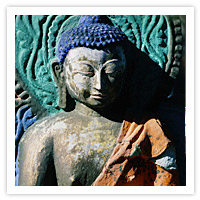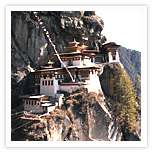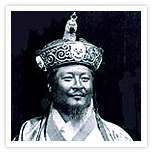Tours to Bhutan, Travel to Bhutan
- Bhutan Visitor Info
- Western Region Bhutan -
- Central Region Bhutan -
- Eastern Region Bhutan -
- Festivals of Bhutan -
- National symbols -
- History of Bhutan -
- Culture of Bhutan -
- Religion of Bhutan -
- People of Bhutan -
- Bhutan Visa & Customs -
- Bhutan Accommodation -
- Bhutan Transportation -
- Climate of Bhutan -
- Currency of Bhutan -
- Paro Festival Bhutan -
- Trekking in Bhutan -
History of Bhutan
For further Details Contact Us
 Although
its a small country, the kingdom of Bhutan is rich in history. The name
'Bhutan' came into use as recently as the 19th century and its origins
remain somewhat unclear. But it is generally believed that the word is
derived from the sanskrit name 'Bhotant' which means the 'end of Tibet'. It
is also known as 'Land of the Thunder Dragon' or Druk Yul- and it's people
call themselves Drukpas.
Although
its a small country, the kingdom of Bhutan is rich in history. The name
'Bhutan' came into use as recently as the 19th century and its origins
remain somewhat unclear. But it is generally believed that the word is
derived from the sanskrit name 'Bhotant' which means the 'end of Tibet'. It
is also known as 'Land of the Thunder Dragon' or Druk Yul- and it's people
call themselves Drukpas. Historically, Bhutan was known by many names, such as
Lho Tsendenjong the Southern Land of the Sandalwood,
LhomenKhazhi the Southern Land of Four Approaches,
Lho Mon the Southern Land of Darkness,
Lho Men Jong the Southern Land of Medicinal Herbs
Motley stone tools, weapons, and remnants of large stone structures provide evidence that Bhutan was inhabited as early as 2000 BC. And historians have gone as far as to say that in the state of Lhomon ( "southern darkness"), or Monyul ("Dark Land"), Monpa - the aboriginal peoples of Bhutan, may have existed between 500 BC and 600 AD. The various names of this land have been chronicled in ancient Bhutanese and Tibetan texts.
Since most of the records were destroyed after fire ravaged Punakha, the ancient capital of Bhutan, in 1827, the early history is somewhat unclear. But by the 10th century, Bhutan's political
 development
was heavily influenced by its religious history due to the fact that the
earliest transcribed event in Bhutan now; was the passage of the Buddhist
saint Guru Rimpoche, also known as Padmasambhava or the second Buddha in the
8th century. He is also known as the father of Tantric Buddhism in Bhutan.
development
was heavily influenced by its religious history due to the fact that the
earliest transcribed event in Bhutan now; was the passage of the Buddhist
saint Guru Rimpoche, also known as Padmasambhava or the second Buddha in the
8th century. He is also known as the father of Tantric Buddhism in Bhutan.
Various sub-sects of Buddhism emerged after the introduction of Drukpa sub-sect of the Kargyupa School( Tantric buddhism), which were patronised by the various Mongol and Tibetan overlords. But after the decline of the Mongols in the 14th century, the Drukpa sub-sect rose to become the dominant sect in 16th century Bhutan.
Till the early 17th century, Bhutan existed as a loosely constructed patchwork of small fiefdoms which were involved in continuous battles amongst themselves. These minor states were unified by the Tibetan lama and military leader Shabdrung Ngawang Namgyal in 1616. He built a network of impregnable dzong (fortresses) to defend the country against constant Tibetan forays. He is also known to have promulgated a code of law which brought the local lords under centralised control. Many such dzong still exist. After Namgyal's death in 1652, Bhutan fell into anarchy.
The 18th century brought the onslaught of yet another era and it began with Bhutan's invasion and occupation of the kingdom of Cooch Behar. A peace treaty was signed between the Bhutanese and British governments but was short lived as the border skirmishes continued for a hundred years leading to the Duar War (1864-1865). The Treaty of Sinchula was signed between British India and Bhutan after it lost the war. And the Duars were ceded to the United Kingdom of Great Britain and Ireland in exchange for a rent of Rs. 50,000.

During the 1870s, power struggles between the rival valleys of Paro and Trongsa led to a civil war in Bhutan, eventually leading to the ascendancy of Ugyen Wangchuck, the ponlop (governor) of Tongsa. In 1907, an epochal year for the country, Ugyen Wangchuck was unanimously chosen as the hereditary king of the country by an assembly of leading Buddhist monks, government officials, and heads of important families. The British government too recognised the new monarchy, and in 1910 Bhutan signed a treaty which let Great Britain control Bhutan's foreign affairs. After India gained independence , Bhutan became of one of the first countries to recognize India's independence.
After the Chinese People's Liberation Army entered Tibet in 1951, Bhutan sealed its northern frontier and improved bilateral ties with India. In 1953, King Jigme Dorji Wangchuck established the country's legislature - a 130 member National Assembly - to promote a more democratic form of governance. In 1965, he set up the Royal Advisory Council, and in 1968 he formed the Cabinet. In 1971, Bhutan was admitted to the United Nations, having held observer status for three years. In July 1972, Jigme Singye Wangchuck ascended to the throne at the age of 16 after the death of his father, Dorji Wangchuck. And today Bhutan is one of the few countries whose path of development leads them to save their natural assets and measure their growth through Gross National Happiness.






